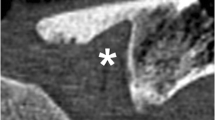Abstract
Computed tomography scans originally obtained to assess the ossification status of the medial clavicular epiphyses of 40 live subjects for forensic age estimation purposes were analysed. From the data acquired we reconstructed images with slice thicknesses of 1, 3, 5 and 7 mm, and based on the classification of stages by Schmeling et al. (Int J Legal Med 118:5–8, 2004), we determined the ossification stage for each reconstructed slice thickness, separately for both sides. Of the 80 clavicular epiphysial plates examined, seven displayed slice-thickness-dependent differences at certain ossification stages. In one case a slice thickness of 1 mm led to a different diagnosis of the ossification stage than a slice thickness of 3 mm, in three cases the diagnoses differed between the slice thicknesses of 3 and of 5 mm, and in another three cases, between 5 and 7 mm. We therefore conclude that for age estimation purposes, the slice thickness should be 1 mm to ensure maximum accuracy and diagnostic reliability.

Similar content being viewed by others
References
Dünkel F, van Kalmthout A, Schüler-Springorum H (1997) Entwicklungstendenzen und Reformstrategien im Jugendstrafrecht im europäischen Vergleich. Forum, Mönchengladbach
Jurik AG, Jensen LC, Hansen J (1996) Radiation dose by spiral CT and conventional tomography of the sternoclavicular joints and the manubrium sterni. Skelet Radiol 25:467–470
Kreitner K-F, Schweden F, Schild HH, Riepert T, Nafe B (1997) Die computertomographisch bestimmte Ausreifung der medialen Klavikulaepiphyse-eine additive Methode zur Altersbestimmung im Adoleszentenalter und in der dritten Lebensdekade? Fortschr Röntgenstr 166:481–486
Kreitner K-F, Schweden FJ, Riepert T, Nafe B, Thelen M (1998) Bone age determination based on the study of the medial extremity of the clavicle. Eur Radiol 8:1116–1122
Olze A, Schmeling A, Taniguchi M, Maeda H, Van Niekerk P, Wernecke K-D, Geserick G (2004) Forensic age estimation in living subjects: the ethnic factor in wisdom tooth mineralization. Int J Legal Med 118:170–173
Olze A, Bilang D, Schmidt S, Wernecke K-D, Geserick G, Schmeling A (2005) Validation of common classification systems for assessing the mineralization of third molars. Int J Legal Med 119:22–26
Paewinsky E, Pfeiffer H, Brinkmann B (2005) Quantification of secondary dentine formation from orthopantomograms—a contribution to forensic age estimation methods in adults. Int J Legal Med 119:27–30
Schmeling A, Reisinger W, Wormanns D, Geserick G (2000) Strahlenexposition bei Röntgenuntersuchungen zur forensischen Altersschätzung Lebender. Rechtsmedizin 10:135–137
Schmeling A, Kaatsch H-J, Marré B et al (2001) Empfehlungen für die Altersdiagnostik bei Lebenden im Strafverfahren. Rechtsmedizin 11:1–3
Schmeling A, Schulz R, Reisinger W, Mühler M, Wernecke K-D, Geserick G (2004) Studies on the time frame for ossification of medial clavicular epiphyseal cartilage in conventional radiography. Int J Legal Med 118:5–8
Schulz R, Mühler M, Mutze S, Schmidt S, Reisinger W, Schmeling A (2005) Studies on the time frame for ossification of the medial epiphysis of the clavicle revealed by CT scans. Int J Legal Med 119:142–145
Author information
Authors and Affiliations
Corresponding author
Rights and permissions
About this article
Cite this article
Mühler, M., Schulz, R., Schmidt, S. et al. The influence of slice thickness on assessment of clavicle ossification in forensic age diagnostics. Int J Legal Med 120, 15–17 (2006). https://doi.org/10.1007/s00414-005-0010-9
Received:
Accepted:
Published:
Issue Date:
DOI: https://doi.org/10.1007/s00414-005-0010-9



